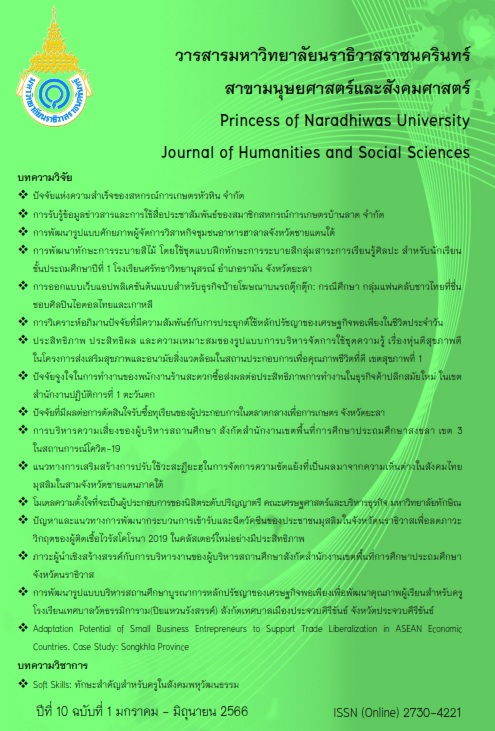Model of Entrepreneurial Intention of Undergraduate Students in Faculty of Economics and Business Administration, Thaksin University
Main Article Content
Abstract
The purpose of this research was to develop the structural equation model of entrepreneurial intention. The sample consisted of 300 undergraduate students in faculty of economics and business administration, Thaksin University. The samples were selected with proportional stratified random sampling. A set of questionnaires was used as a research instrument which measured on five-point Likert scales. The examination of content validity was measured by item-objective congruence (IOC) ranged from 0.67-1.00, and the reliability of the instrument in term of Cronbach’s alpha coefficient was 0.934. The developed Structural Equation Model (SEM) consisted of 4 latent variables and 15 observed variables. The primary data were analyzed by descriptive statistics, and the goodness of fit of the model was assessed by using structural equation modeling. The results revealed that the measurement model accounted for construct reliability of 0.81-0.85 and average variance of 0.57-0.63. The SEM model was found to have a good fit for the empirical data (X2/df=1.74, GFI=0.95, CFI=0.98, RMR=.012, RMSEA= 0.034). The entrepreneurial motivation, entrepreneurship education and entrepreneur’s characteristic affected entrepreneurial intention with an effect size of 0.50, 0.52 and 0.38 at a significant level of 0.05. Additionally, entrepreneurial motivation and entrepreneurship education factor were found to affect entrepreneur’s characteristic with an effect size of 0.45 and 0.48 at a significant level of 0.05.
Article Details

This work is licensed under a Creative Commons Attribution-NonCommercial-NoDerivatives 4.0 International License.
References
กลุ่มภารกิจทะเบียนนิสิตและบริการการศึกษา มหาวิทยาลัยทักษิณ. (2565). สถิตินิสิตปัจจุบัน (จำแนกตามสาขา/ชั้นปี). สืบค้นจาก https://misreg.tsu.ac.th/stat/search_all.jsp?lang=th
กัลยา วานิชย์บัญชา. (2562). การวิเคราะห์สมการโครงสร้าง (SEM) ด้วย AMOS (พิมพ์ครั้งที่ 4). กรุงเทพฯ: สำนักพิมพ์แห่งจุฬาลงกรณ์มหาวิทยาลัย.
จริยา กอสุขทวีคูณ. (2561). การศึกษาแรงจูงใจและความตั้งใจในการเป็นผู้ประกอบการของนักศึกษาระดับอุดมศึกษาในประเทศไทย (วิทยานิพนธ์ปริญญาการจัดการมหาบัณฑิต). มหาวิทยาลัยกรุงเทพ, ปทุมธานี.
ธาดาธิเบศร์ ภูทอง. (2562). ความสัมพันธ์เชิงสาเหตุของปัจจัยที่ส่งผลต่อความตั้งใจที่จะเป็นผู้ประกอบการและสร้างธุรกิจดิจิทัลใหม่ของนักศึกษาระดับปริญญาตรี. วารสารวิทยาการจัดการ มหาวิทยาลัยสงขลานครินทร์, 36(2), 31-59.
พรรณสิยา นิธิกิตติ์สุขเกษม, และบุญฑวรรณ วิงวอน. (2561). โมเดลความตั้งใจในการเป็นผู้ประกอบการของผู้เรียนโครงการศูนย์บ่มเพาะวิสาหกิจ. วารสารวิชาการบริหารธุรกิจ สมาคมสถาบันอุดมศึกษาเอกชนแห่งประเทศไทย, 7(1), 146-161.
พัชรินทร์ เพชรช่วย, ปลื้มใจ ไพจิตร, และรัตติยาภรณ์ รอดสีเสน. (2564). คุณลักษณะของผู้ประกอบการที่ส่งผลต่อความสำเร็จในการบริหารงานของวิสาหกิจขนาดกลางและขนาดย่อม กรณีศึกษา อุตสาหกรรมปาล์มน้ำมันในจังหวัดสุราษฎร์ธานี. วารสารวิทยาการจัดการ, 8(1), 107-124.
ภัทรานิษฐ์ สรเสริมสมบัติ. (2563). คุณลักษณะที่ส่งผลต่อความตั้งใจเป็นผู้ประกอบการ: กรณีศึกษา นักศึกษาบริหารธุรกิจ มหาวิทยาลัยราชภัฏเชียงใหม่. วารสารวิทยาการจัดการ มหาวิทยาลัยราชภัฏเชียงราย, 15(2), 117-142.
สำนักงานเลขาธิการสภาการศึกษา. (2561). การจัดการศึกษาเพื่อพัฒนาความเป็นผู้ประกอบการ. กรุงเทพฯ: สำนักวิจัยและพัฒนาการศึกษา กระทรวงศึกษาธิการ.
อนงค์ รุ่งสุข. (2559). ปัจจัยที่มีผลต่อความตั้งใจที่จะเป็นผู้ประกอบการของนักศึกษาคณะบริหารธุรกิจ มหาวิทยาลัยเทคโนโลยีราชมงคลรัตนโกสินทร์ (วิทยานิพนธ์ปริญญาบริหารธุรกิจมหาบัณฑิต). มหาวิทยาลัยเทคโนโลยีราชมงคลรัตนโกสินทร์, นครปฐม.
อโนมา ภาคสุทธิ, ผ่องพรรณ เกิดพิทักษ์, และประสาร มาลากุล ณ อยุธยา. (2563). การเป็นผู้ประกอบการที่ประสบความสำเร็จ. วารสารจิตวิทยา มหาวิทยาลัยเกษมบัณฑิต, 11(2), 75-85.
Ajzen, I. (1991). The Theory of Planned Behavior. Organizational Behavior and Human Decision Processes, 50(2), 179-211.
Che Embi, N.A., Jaiyeoba, H.B., & Yussof, S.A. (2019). The Effects of Students’ Entrepreneurial Characteristics on their Propensity to Become Entrepreneurs in Malaysia. Education and Training, 61(7), 1020-1037.
Gilad, B., & Levine, P. (1986). A Behavioral Model of Entrepreneurial Supply. Journal of Small Business Management, 24(4), 45-54.
Hair, J. F., Hult, G. T. M., Ringle, C. M., & Sarstedt, M. (2014). A Primer on Partial Least Squares Structural Equation Modeling (PLS-SEM). California, CA: Sage
Hou, F., Su, Y., Lu, M., & Qi, M. (2019). Model of the Entrepreneurial Intention of University Students in the Pearl River Delta of China. Frontiers in Psychology, 10(1), 1-16.
Luc, P. T., Lan, X.P., & Trang, T. B. (2021). Personality Traits and Social Entrepreneurial Intention: The Mediating Effect of Perceived Desirability and Perceived Feasibility. The Journal of Entrepreneurship, 30(1), 56-80.
Mei, H., Lee, C-H., & Xiang, Y. (2020). Entrepreneurship Education and Students' Entrepreneurial Intention in Higher Education. Education Sciences, 10(1), 1-18.
Mónico, L., Carvalho, C., Nejati, S., Arraya, M., & Parreira, P. (2021). Entrepreneurship Education and its Influence on Higher Education Students’ Entrepreneurial Intentions and Motivation in Portugal. Brazilian Administration Review, 18(3), 1-27.
Shapero, A., & Sokol, L. (1982). The Social Dimensions of Entrepreneurship, In C. Kent, D. Sexton, and K. H. Vesper (eds.) The Encyclopedia of Entrepreneurship. Englewood Cliffs, NJ: Prentice-Hall.


